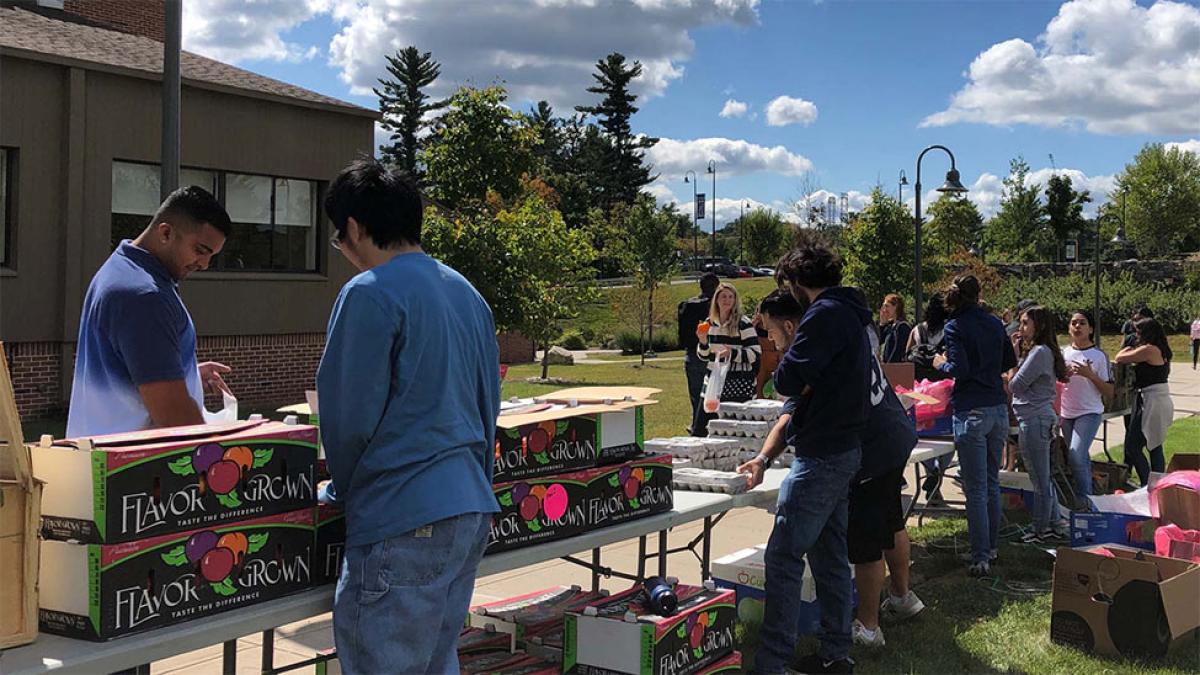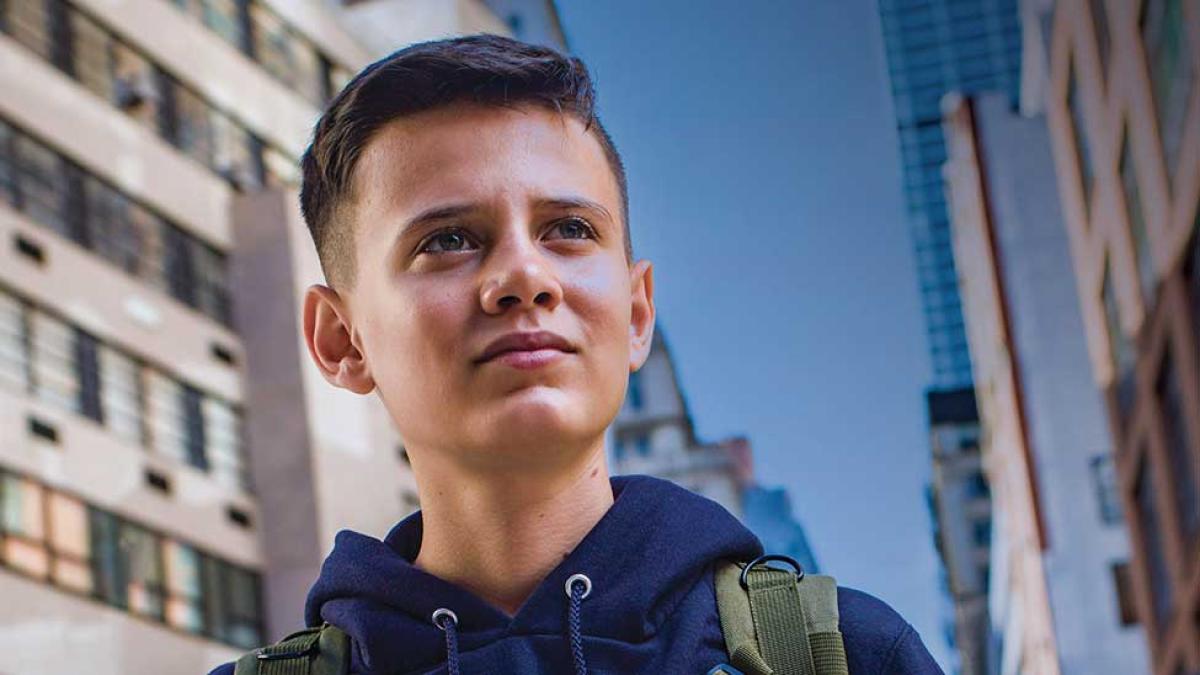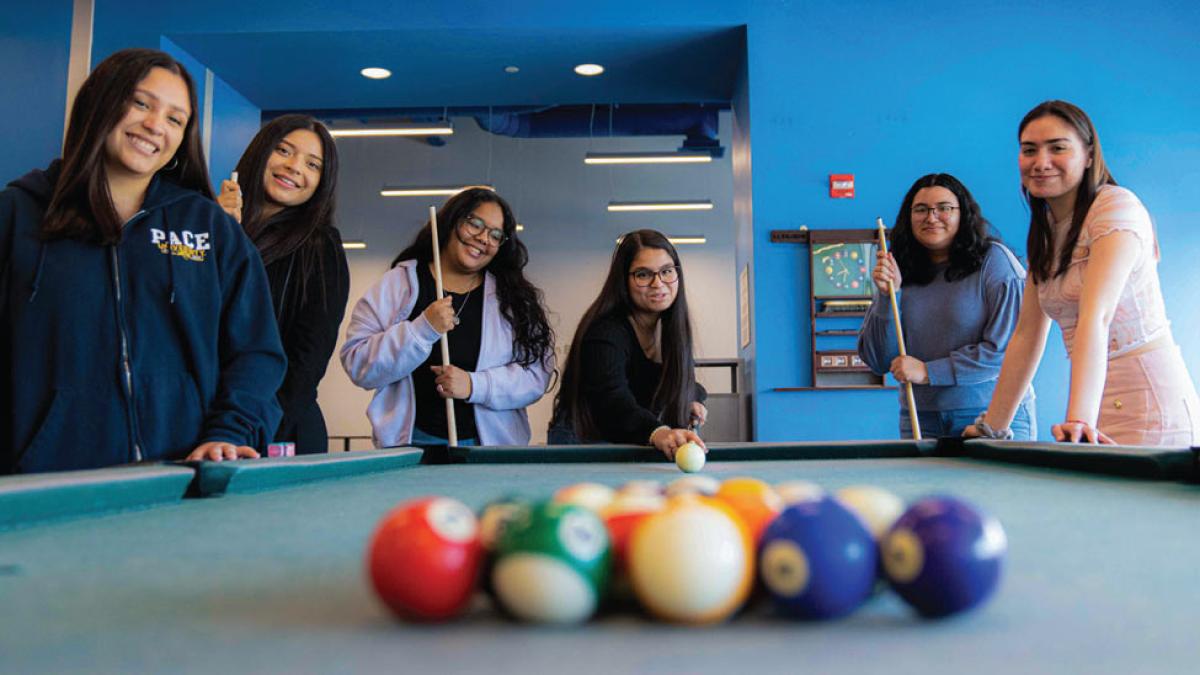
Fare Trade/Fair Chance
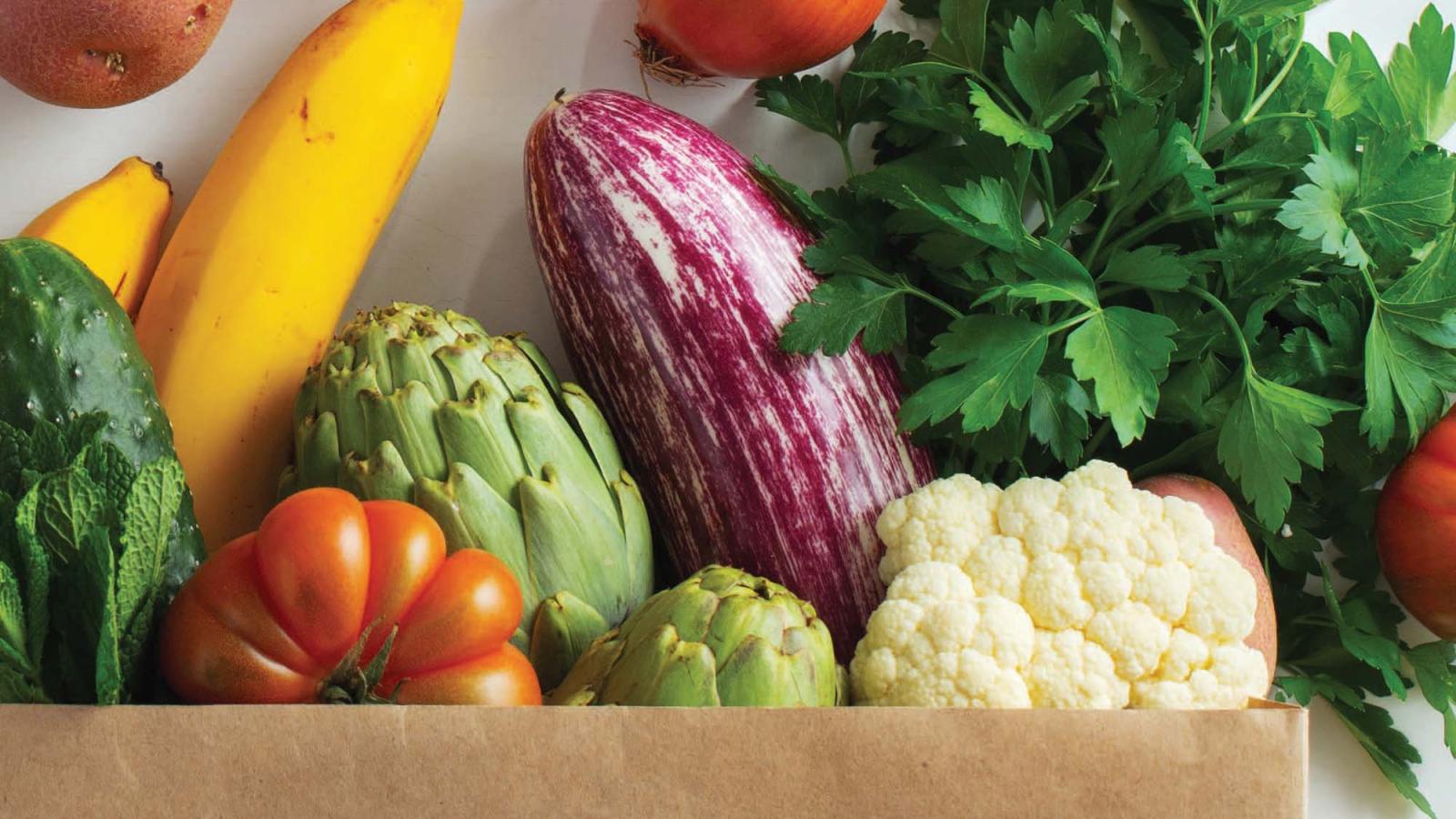
Surviving on Instant Ramen.
This is the image of the quintessential college student—perpetually tired but unrelenting, hungry yet insatiable.
Unfortunately, the “starving college student” is less romantic notion and more harsh reality. Across the country, nearly 40 percent of college students report going hungry, and 52 percent have utilized food pantry services at some point.
College is expensive. Living (and eating) in New York City is expensive. And with two years of a destabilizing pandemic further increasing disparities, food insecurity on college campuses is only getting worse. Fortunately, the fight against food insecurity at Pace just gained three dedicated advocates.

Agents of Change
Pace is part of the United Nations Millennium Campus Network, a global student movement designed to address our society’s greatest challenges. Students at network schools can apply to be part of the UN Millennium Fellowship. This is an incredibly selective program, with only 6 percent of students worldwide chosen. Yet for the past three years, nine Pace students per year have been made Fellows.
Change-making students apply to this program with the goal of tackling one of the UN’s seventeen Sustainable Development Goals. “These are goals that leaders from all over the world, about 190 countries, put together to promote peace, justice, and environmental sustainability,” says Sue Maxam, EdD, assistant provost for Special Projects and Retention Initiatives, and Pace’s liaison for the program.
For many, the program is a chance to learn something hands-on and add to their resume. But for Fellows Alexandra Kennedy ’22, Marisa Medici ’22, and Tasfia Rahim ’23, this was their chance to change their school for the better.
Goal: Zero Hunger
Alexandra Kennedy was already immersed in the fight against food insecurity as a volunteer at Pace’s food pantry Provisions. Growing up food insecure meant she also had firsthand experience. “When I came to college, I didn’t have any money and my meal plan money typically ran out very quickly,” says Kennedy. “Honestly, when we were sent home for COVID [in Spring 2020], I said ‘thank goodness’ because I only had a hundred dollars left for the semester.”
For Tasfia Rahim, it did not escape her notice how much the pandemic had changed her community, with food pantry lines growing longer by the day. “Seeing that, it really tapped into my interest in what food insecurity is and its prevalence in my community,” she says.
"A lot of students have to decide whether they want to continue to pay for tuition, housing, or books rather than feeding themselves." —Rahim
Marisa Medici can’t help but connect food insecurity to deeper systemic issues that she finds fascinating—and concerning. “Personally, I’m interested in the complexities of the food production/distribution system,” she says. “I feel like a lot of people aren’t aware how they contribute to some of the most temporarily pressing issues—from carbon emissions to increasing health disparities.”
They knew their peers were struggling, even going so far as skipping meals they couldn’t afford and taking “poverty naps,” sleeping to keep hunger at bay. Maxam brought the three students together and they decided to take on the UN’s second goal of Zero Hunger, believing they could find tangible solutions to ease food insecurity on campus. And so, they got to work.
The Cost of Going Hungry
When Denise Santiago, PhD, director of Pace’s Office of Multicultural Affairs, set out to create a campus food pantry in 2014, she conducted a survey to gauge need. The results were concerning. “We had 1,500 students that were living below the poverty line,” says Santiago. “But we don’t know the number living at the poverty level, or slightly above—which is also cause for food insecurity, especially in places like New York City.” The results of the survey were part of the impetus for the creation of Provisions, a Bhandari Jain Family Food Pantry on Pace’s NYC Campus.
Maxam worries students are going hungry to pay for an education that is ultimately impacted when they go without enough food. “Students who deal with hunger get lower grades, very often they withdraw from college, if they withdraw or drop out entirely, they end up applying for lower paying jobs, they still have their college debts and they have to repay their loans,” she says. “It’s a vicious cycle.”
“We want to make sure they are being supported and can succeed. That requires being healthy in mind, body, and soul.” —Medici
“Society normalizes the idea of college students eating ramen or mac ‘n’ cheese, but it’s problematic because a lot of students have to decide whether they want to continue to pay for tuition, housing, or books rather than feeding themselves,” adds Rahim.
“We want to make sure our peers are set up for academic success and are aware of food insecurity, and that they don’t feel ashamed by it. It’s more common than a lot of people think,” says Medici. “We want to make sure they are being supported and can succeed. That requires being healthy in mind, body, and soul.”
Food for Thought
Even before they were formally accepted into the Millennium Fellows program, the students were already hard at work conceptualizing solutions. They were certain of one thing: they didn’t want their project to be theoretical or temporary, but sustainable and institutionalized to serve the Pace Community for the long term.
The idea started from their observations and grew. “We knew that graduating students had a surplus of meal plan money and nowhere for that money to go,” says Kennedy. At Pace, unused meal plan money is forfeited at the end of the spring semester, meaning many students went home for the summer or graduated with unused balances on their meal plan. “We felt that students should be able to share that with each other, especially if that money would just go away when they graduated.”
“Food insecurity is not a one size fits all issue, so it shouldn’t be a one size fits all approach.” —Medici
This observation eventually materialized into Fare Trade, a program that would empower students to re-allocate excess meal plan money to other Pace students who may be in need—a fair trade for food fare.
Charting the Course with Chartwells
John Olsson arrived at Pace 10 years ago as a chef for Chartwells, Pace’s dining service provider. Now he’s the Director of Dining Services and he’s seen several programs dedicated to combating hunger.
With the help of Olsson and Pace’s Auxiliary Services team, the three students were able to bring Fare Trade to life. Here’s how it works: when students pay using meal plan money in the dining hall, they can donate up to $5 which goes into a fund that is then distributed to students in need towards the end of the semester, when meal plans tend to run low.
Through Fare Trade, food insecure students can confidentially get the support they need, whether they are chronically food insecure, or just going through a rough patch. “No one is going to know about your situation,” Rahim says. “Our ultimate goal is to help you.”
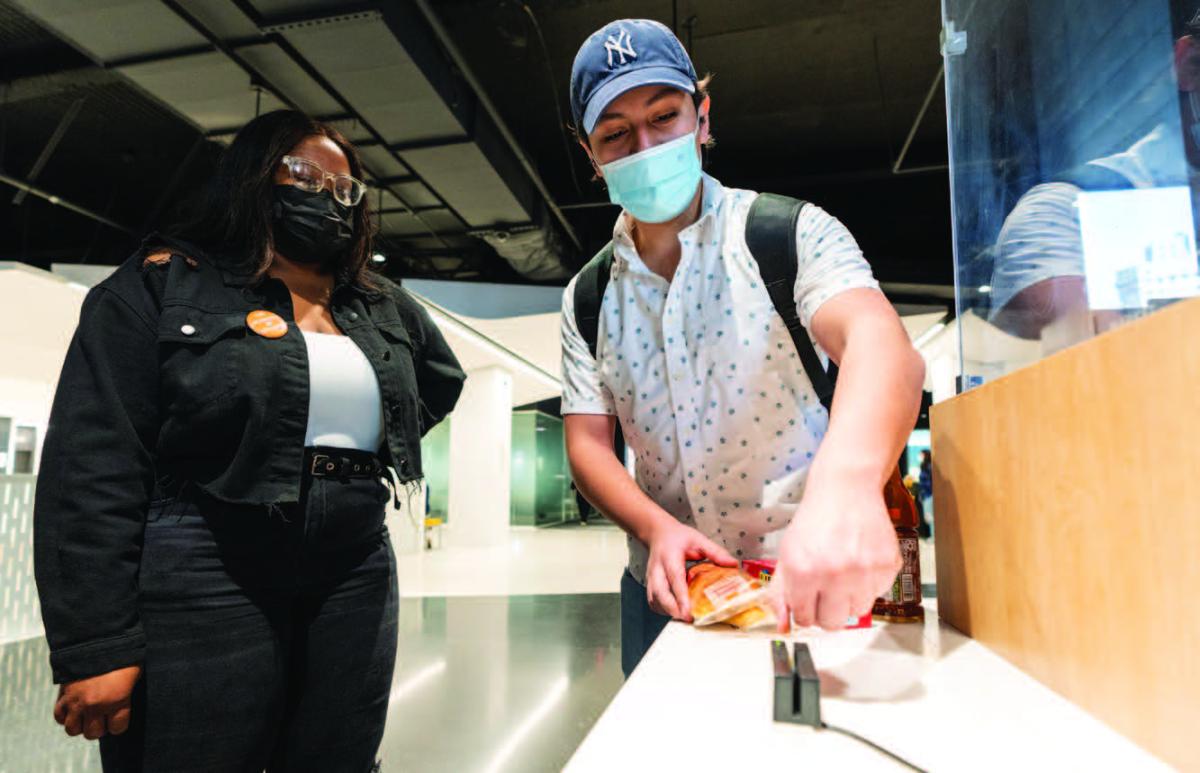
Provisions Providing
They could have stopped with Fare Trade, but the students felt they could do more. “Food insecurity is not a one size fits all issue,” Medici says, “so it shouldn’t be a one size fits all approach.”
They looked to the Provisions food pantry and brainstormed ways to increase its impact. Santiago, the founder of Provisions, was concerned especially about members of Pace’s Active Retirement Community, a formal social group for NYC senior citizens. “One of our collective concerns is how to get our pantry items to that community, especially during inclement weather or when they are not feeling well,” she says.
To support these senior citizens, the Fare Trade team partnered with Invisible Hands Deliver, a nonprofit dedicated to delivering groceries to the most vulnerable during COVID-19. Now, anyone who relies on Provisions could get their food pantry groceries delivered to them.
With the delivery service established, the Fare Trade trio turned once more to spreading awareness about food insecurity.
For Students by Students
Professor Meghana Nayak, PhD, chair of the Women’s and Gender Studies Department, met the Millennium Fellows after seeking out resources for one of her students facing food insecurity. She shared their vision of seeing the program institutionalized and offered up Pace’s Women’s and Gender Studies department as a sponsor. “The people who experience food insecurity are also more likely to experience the forms of oppression that we study when we are looking at feminist theories and social justice movements,” she says.
Even though Kennedy, Medici, and Rahim connected with and involved academic and administrative departments at Pace, they continued to stay dedicated to one of their earliest decisions—this would be a program for students, by students.
“When there’s a problem, students should feel like they have the chance to help.” —Kennedy
“We were really embraced so much by Pace administration and faculty so that we could take the lead,” says Medici. “They were really comfortable with letting us make those mobilizing actions and being that support system for us. We are so grateful every day.”
Empowerment is a key phrase when it comes to Fare Trade, as the students wanted to emphasize the power of community mobilization. “Students make up a majority of the Pace Community,” Kennedy says. “When there’s a problem, students should feel like they have the chance to help.”
Medici wants her peers to see that a big impact can start small, and that what they are learning can contribute to making their community better. “Every small change can make a bigger difference,” she says. “It’s about fostering that community around wanting to do public service and civic engagement work and how important that can be.”
“Every wonderful thing we have at Pace is because a student thought, ‘What if this could happen?’ or because they have taken a great idea to the next level.” —Nayak
This Year, and The Next, and the Next
It will be some time before the impact of Fare Trade can be officially measured and quantified—but the short-term effects are clear.
“This program will grow beyond them,” says Olsson of Chartwells. “We’ll use it as a model at other schools, because it really is an engaging way for students to pay it forward.”
For Nayak, Fare Trade is another example of student excellence at Pace. “Every wonderful thing we have at Pace is because a student thought, ‘What if this could happen?’ or because they have taken a great idea to the next level.”
“Fare Trade is leading by example. It ties into Pace’s mission of Opportunitas—that experiential learning,” says Medici. “We’re taking what we’re learning in the classroom and being able to apply that critical thinking in real life.
More from Pace Magazine
Community led food pantries have been supporting Pace Community members facing food insecurity for many years. See the options in Westchester and New York City.
At 14 years old, Shahab Gharib is not your typical Pace student. Here is his extraordinary story.
With the help of a nearly $2M federal grant, this inaugural cohort of nursing students is poised to change the face of patient care.
